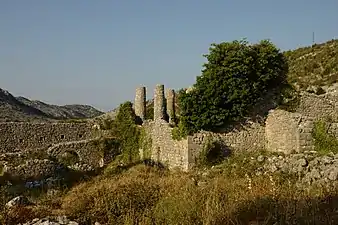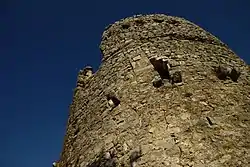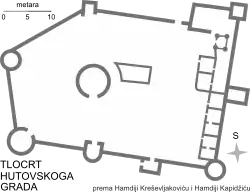Hutovo fortress
Hutovo fortress or Hadžibegov Grad (the Hajji bey fort),[1] also Hutovski Grad, is a fortress in Bosnia and Herzegovina in the municipality of Neum near the village of Hutovo.[2][3]
| Hutovo fortress | |
|---|---|
Hadžibegov Grad (Hajji bey fort) | |
| Neum, Bosnia and Herzegovina | |
 Hadžibegov Grad (Hajji bey fort) | |
 Hutovo fortress | |
| Coordinates | 42.9510122°N 17.8031275°E |
| Type | Castle, fortification) |
| Site information | |
| Owner | Rizvanbegović noble family |
| Controlled by |
|
| Condition | Ruined (National Monument of Bosnia and Herzegovina) |
| Site history | |
| Built | earliest record June 28, 1525 |
| In use | 1525-1878 |
| Materials | Limestone |
| Demolished | torched 1875-1878 |
| Battles/wars | 1875-1878 uprising |
| Garrison information | |
| Past commanders | Hajji Mehmed bey Rizvanbegović |
| This site is protected and listed as a National Monument of Bosnia and Herzegovina by the Government of BiH and its KONS[1] | |
Location and Name

The fortress is located along a narrow road leading from Hutovo Blato to Neum, below Žaba mountain and southwest of Hutovo.[4] Strategically situated atop a hill overlooking the Prešjeci pass, it was often traversed by salt caravans from Ston traveling inland. The name Hadžibegov Grad is derived from the last lord's name, Hadžibeg Rizvanbegović.[2][1]
Description

The structure forms an irregular pentagon.[1] There is a total of nine towers, each in a corner of the fortress. Solid and high walls enclose an area of flat land.[2] The fortification runs east to west 70 m. The eastern portion of the fortress is roughly 50 m in width, while the western portion is 30 m in width. Its walls were constructed in such a way that soldiers armed with firearms could defend every angle of the fortress.[1]
History

Contemporary usage
The society of Friends of the Old Hutovo use town historical settings for local celebrations.[2]
Protection
Revitalization of the fort was started in 1969 by the National museum of Bosnia and Herzegovina.[5]
On May 10, 2004, the Commission to Preserve National Monuments of Bosnia and Herzegovina designated it a "historic site".[1] Three slabs bearing inscriptions found at the fortress are on display in Country House museum's lapidary in Hutovo.[1]
See also
| Wikimedia Commons has media related to Category:Hutovo Fortress. |
References
- "The historic site of the Hutovo fort (Hadžibegov grad – the Hajji bey fort) in Hutovo". old.kons.gov.ba (in Serbo-Croatian and English). Commission to preserve national monuments. 5 May 2004. Retrieved 3 July 2019.
- Priča o hutovskom gradu Čapljinski portal/hum.ba, Nedjelja, 06 Siječanj 2013
- Povijest poznavanja Dinarskog krša na primjeru Popova polja Ivo Lučić, disertacija, Nova Gorica: Sveučilište u Novoj Gorici, 2009.
- Povijest poznavanja Dinarskog krša na primjeru Popova polja Ivo Lučić, disertacija, Nova Gorica: Sveučilište u Novoj Gorici, 2009., str. 200
- Povijest poznavanja Dinarskog krša na primjeru Popova polja Ivo Lučić, disertacija, Nova Gorica: Sveučilište u Novoj Gorici, 2009., str. 180
